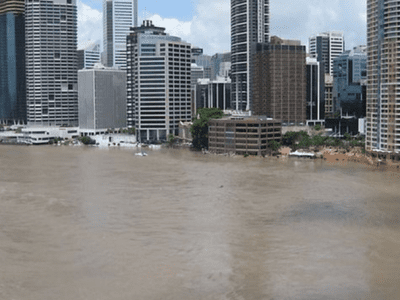NATURAL DISASTER REPORT OF THE PRODUCTIVITY COMMISSION

Brisbane floods, 2011
On 17 December, 2014, the Productivity Commission (PC) presented its must read, final report on Natural Disaster Funding Arrangements (Report No. 74) [Vol 1 & Vol 2] to the Australian Government. Five months later, on 1 May, the Government released the report, just before the budget. In responding to the final report, the Minister for Justice, Michael Kennan, said he would consult with the states to address the findings: “ I have made it clear that the Australian Government is not proposing any radical reductions in the funding support it provides to the states. Instead we will seek a more modest and gradual approach to getting the balance of mitigation and recovering funding right”, he said. What does this really mean?
It should be noted that it was the Treasurer that instigated this Inquiry and issues raised must at some stage be vital to budgets of the Commonwealth and states. But under current administrative arrangements matters dealing with disasters at the federal level are handled by the Minister for Justice! What is critical is that if this Government is serious about reducing the massive liabilities that fall outside budgets, but then must somehow be paid for (remember the one-off tax levy to help Queensland after the devastation of 2011), efforts must be made to mitigate the impacts of disasters.
Treasurer Hockey in setting up this Inquiry in 2014, stated that the Commission should take into account the priority of effective mitigation to reduce the impact of disasters on communities. The PC has done just that and the response from the Justice Minister reflects what is obviously a high degree of political sensitivity in placing more onus on the states to do more in anticipation of recurring disasters. Reaction from the states is understandable given the PC recommendation for a reduction in the share of disaster recovery costs from the federal government from the current level of 75% to 50%, and the threshold for eligibility for such funding be lifted. But to compensate there would be increases in budget funding for mitigation activities to $200 million a year.
It its statement of key points, the PC makes it very clear that effective planning and mitigation of risks is an essential task of governments, businesses and households. Current funding arrangements are not efficient, equitable or sustainable (with or without climate change effects). As a nation we over invest in post-disaster reconstruction (way in excess of OECD average). The PC recommends that in order to better prepare for the future, the states must do more along with local governments, hence the caution from Keenan at this time. However, submissions to the PC from a range of interests made it clear that natural disaster costs are becoming a growing unfunded liability for governments and communities. Powers vested in the different levels of government in Australia should involve changes in funding arrangements, planning outcomes and actions to help reduce adverse impacts on people’s lives, business operations and the environment. One key point made by the PC that resonates with me is “a need to transparently incorporate natural disaster risk management into land use planning”.

ACS made formal submissions to the PC during the course of its Inquiry. I would like to thank all involved especially Angus Gordon and Tom Fitzgerald.
Tom represented ACS at a hearing on 27 October while the rest of us were in WA at Coast to Coast. He stressed the importance of coastal hazards of various types and difficulties facing state and local councils in addressing adverse impacts. The need for integrated land use plans was noted. The Wentworth Group in its submission and appearance before the PC made the same point whilst also stressing potential exacerbation of risk due to climate change. There can be no doubt that population growth and economic activities around the Australian coast will continue to grow placing more properties, infrastructure, environmental assets and lives at risk. States have the statutory responsibility to plan and manage the coast in association with local government. What we have to be alert to are any ideas to reduce risk that in themselves create adverse impacts on the coast.
Experience in the USA and Europe makes us alert to what can be termed maladaptive responses to risk in coastal settings. Thus we must be in a position to advise governments on ways to reduce risk without placing more natural and built assets in harm’s way.
– words by Prof. Bruce Thom

